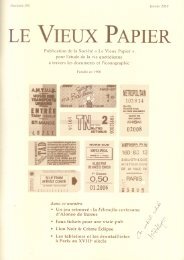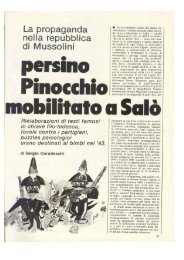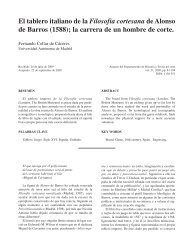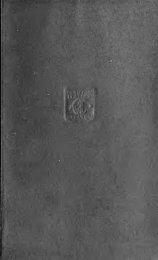Board games from the city of Vijayanagara (Hampi ... - Gioco dell'Oca.
Board games from the city of Vijayanagara (Hampi ... - Gioco dell'Oca.
Board games from the city of Vijayanagara (Hampi ... - Gioco dell'Oca.
Create successful ePaper yourself
Turn your PDF publications into a flip-book with our unique Google optimized e-Paper software.
P. M ICHAELSEN, ON SOME UNUSUAL TYPES OF STICK DICE 15<br />
The game played with this special dice stick was far <strong>from</strong> unusual. In <strong>the</strong> aforementioned<br />
article I have demonstrated that variants <strong>of</strong> this game have been popular in large<br />
parts <strong>of</strong> Europe for centuries. A passage in a poem by <strong>the</strong> Scottish poet William Dunbar<br />
<strong>from</strong> around 1500-1520: “He playis with totum, and I with nichell” is probably an early<br />
allusion to <strong>the</strong> game, later known as teetotum or put-and-take in English. (17) 14th and<br />
15th-century French references to pirouelle and pirouette show that this game was known<br />
already in <strong>the</strong> Middle Ages. (18)<br />
It appears that in all <strong>the</strong> countries where <strong>the</strong> ‘put-and-take’ game was played, it was<br />
played with a dice top or spinner, in principle similar to <strong>the</strong> previously mentioned Sámi<br />
top, but with Latin letters inscribed on its<br />
sides (Fig. 9).<br />
In at least one part <strong>of</strong> Northzen<br />
Europe ano<strong>the</strong>r tradition was followed. In<br />
Denmark and Nor<strong>the</strong>rn Germany, stick<br />
dice with Latin letters were still in use in<br />
<strong>the</strong> early 20th century. My investigation<br />
<strong>of</strong> game names found on <strong>the</strong> index cards<br />
at <strong>the</strong> two Danish University departments<br />
where Danish dialects are studied, shows<br />
that <strong>the</strong> dice top or spinner was popular<br />
in most parts <strong>of</strong> Jutland, Zealand and on<br />
some <strong>of</strong> <strong>the</strong> smaller Danish isles, Lolland,<br />
Falster, and Møn. (19)<br />
On <strong>the</strong> island <strong>of</strong> Funen <strong>the</strong> dice stick<br />
was apparently predominant. From<br />
among a dozen descriptions <strong>of</strong> instruments<br />
used for ‘put-and-take’ <strong>games</strong>, only<br />
one <strong>of</strong> <strong>the</strong>m describes <strong>the</strong> dice top. Dicestick<br />
descriptions are also known <strong>from</strong><br />
South Zealand, <strong>the</strong> island Samsø north <strong>of</strong><br />
Funen, <strong>from</strong> Vendsyssel in North Jutland,<br />
Fig. 9. Dice top (sulletopp) for <strong>the</strong> game<br />
putti <strong>from</strong> Jæren, Norway. (Drawing: Alf<br />
Næsheim 2002). Sometimes <strong>the</strong> I was<br />
replaced by an N (nichts). In Stavanger<br />
this game was called pompi (see<br />
Nordland 1974 and Watne 1990/1991).<br />
and <strong>from</strong> <strong>the</strong> Tønder area in <strong>the</strong> extreme south <strong>of</strong> Jutland, which is near <strong>the</strong> Danish-<br />
German border. This tradition was also in use on <strong>the</strong> North Frisian isles Föhr and<br />
Amrum just south <strong>of</strong> <strong>the</strong> same border, in Dittmarschen on <strong>the</strong> west coast <strong>of</strong> Holstein,<br />
in Nor<strong>the</strong>rn Germany, and in Hamburg.<br />
The prismatic, four-sided dice sticks varied in size: <strong>the</strong> smallest were less than 15<br />
mm thick and 40 mm long, while <strong>the</strong> largest measured some 25 mm in width and 125<br />
mm in length. The average size was probably approximately 20 by 50 or 60 mm. Latin<br />
letters were cut, written or painted on each side <strong>of</strong> <strong>the</strong> stick. Like <strong>the</strong> daldøsa dice, <strong>the</strong><br />
carved letters were sometimes blackened, and <strong>the</strong> corners could be rounded.<br />
The stick was thrown up into <strong>the</strong> air, rolled over a table or between <strong>the</strong> palms <strong>of</strong> <strong>the</strong><br />
hands, or <strong>the</strong> edge <strong>of</strong> it was pressed by a finger tip which made it roll over. It was usually<br />
played around a board or on <strong>the</strong> ground. Even though it was mainly a boy’s game,







